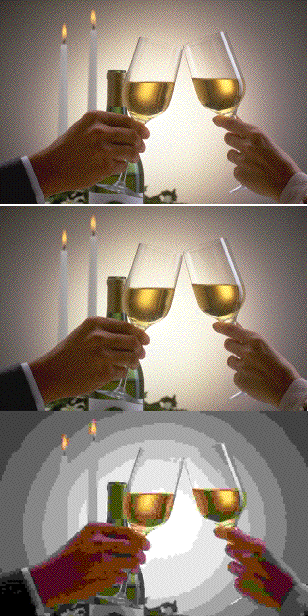
techniques. It is the commercialized version of highly sophisticated imaging technology devel-
oped by LuraTech, Incorporated for German space satellite imaging applications, and for
Ericsson image transmission via cell phone. LuraTech was founded in 1993 and its technology
was refined from research that was conducted jointly with the German National Space Agency
(DLR) and university partnerships. LuraTech maintains academic research partnerships with
Stanford and FHTW Berlin universities.
_________
*LuraTech, Inc., 541 Cowper St., Suite F, Palo Alto, CA 94301, 650 326-8829, http://
www.luratech.com, fax: 650 326-8840.
primary one being that it produces highly compressed files that maintain a high level of image
quality. It does so by analyzing the entire image, and when used at lower compression levels
(up to 1:10), removes the visual elements that are not humanly perceptible. According to
LuraTech’s director of research and development, Kai Barthel, “More than 90% of the data
contained in an image is unnecessary. The wavelet identifies redundancies and eliminates the
unnecessary data.”*
________
*“Managing Loss,” Printing World, Anonymous, September 11, 2000.
to JPEG, since LuraWave incorporates capabilities that define JPEG2000, the successor to JPEG
(FIG. 1). JPEG, released in 1988, uses the Discrete Cosine Transform which compresses an
image into 8 x 8 pixel tiles. The tiles are numbered and are reassembled, in top to bottom order,
when they are viewed. A major disadvantage of the JPEG format is that it can produce un-
sightly blocking artifacts, especially noticeable in areas where subtle color changes are ex-
pected, such as in the sky and in fleshtones. LuraWave uses the Discrete Wavelet Transform,
which works on the entire image and does not produce artifacts, even at high compression
ratios. LuraWave compressed images are encoded in a series of “decomposed bands,” with
each band containing information about the entire image. The bands differ by the specific
image data that they possess, starting with gross texture data and moving to fine detail data.

FIG.![]() 1: The original 3.1MB TIFF file on the top (A), the 19K LuraWave file in the middle (B),
1: The original 3.1MB TIFF file on the top (A), the 19K LuraWave file in the middle (B),
and the 19K JPEG file on the bottom(C). Images reprinted with permission from LuraTech, Inc.
LuraTech(R) and LuraWave(R)are registeredtrademarks of LuraTech, Inc. and LuraTech
GmbH.


![]() The JPEG2000 format, under development since 1998 by the Digital Imaging Group
The JPEG2000 format, under development since 1998 by the Digital Imaging Group
(DIG)* and the ISO JPEG2000 working group, uses technology that is based on wavelet com-
pression, like LuraWave. Also like LuraWave, JPEG2000 offers both lossy and lossless compres-
sion. JPEG is by definition a lossy process which degrades further with each compression/
decompression cycle. JPEG2000 is as much as 20% more efficient in its compression method as
compared to JPEG. In addition, there are no standard JPEG quality settings, since different
implementations of the JPEG quality scales have different meanings.
__________
*Active participants include Alinari Photo Archives, Agfa, Canon, Corbis, Digital Intelligence,
Eastman Kodak, Hewlett Packard, LuraTech, NETIMAGE, and TrueSpectra. The JPEG2000
standard is specified in two parts, one available for free, and the other proprietary and pat-
ented, and requiring licensing agreements.
When the JPEG2000 specification was officially finalized, in January, 2000, Kai Barthel of
LuraTech stated: “The standard is now available to all developers. Luckily, we have 90 percent
of the techniques specified for JPEG2000 already built into our LuraWave compressor, so we
can recycle much of that technology. We will, however, have to rewrite our encoder.”*
__________
*“JPEG2000 Wavelet Compression Spec Approved,”R. Colin Johnson, January 3, 2000, Elec-
tronic Engineering Times, page 14.
to 256 channels of data, so that it can support CMYK or other color models. In addition it can
embed full ICC profile information, and be delivered at the device-appropriate resolution,
from 24-bit color monitors to 4-bit dithered grayscale on PDA screens.
the user. Two significant options areProgressive by Resolution![]() and
and![]() Progressive by Quality.
Progressive by Quality.![]() In the
In the
first case, the user is provided with a low resolution version of the image, and additional detail
can be added at the user’s request. In the second case, the image is provided at full resolution
initially, but with the lowest bits per pixel level. The user can request more bits per pixel to see
increasingly more colors.
helper application, Photoshop plug-in, or standalone program, can utilize the image in the
way that they want, with interactive cropping, panning and zooming. In this way an on-line
user can concentrate on a particular area of interest without needing to download the entire
full-resolution image.
content of the image, such as its name, related keywords, and copyright data. This information
can also be accessed with the proper software.
each image is generated with a unique number, referred to as its “license plate.” The number